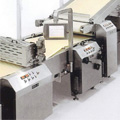CONFECTIONARY
Confectionery in Europe is a relatively mature market progressing modestly by approx. 2% a year. The major drivers in the market are health, pleasure and convenience. Confectionery manufacturers are aiming to appeal to health-conscious consumers with functional innovations, whilst trying to remain indulgent.
Sugar-free confectionery constitutes about 10% of the confectionery market in Scandinavia with a 15% annual growth. Chewing gum dominates the sugar-free confectionery market, but the sugar-free trend is spreading to chocolate confectionery as well.
Other current trends on the European market are:
- Provenance and authenticity. Single-origin chocolate has experienced high growth over the past years. Consumers are choosing chocolate according to region and the level of cocoa solids (>70 %).
- Sustainability and corporate social responsibility constitute a new way for signalling high morals.
- Functional gum brands are taking shares from regular brands. To compete with this, chewing gum companies must invest in innovation by adding value through functional ingredients.
- New EU health and nutrition claims regulation. This came into force in all EU member states on July 1, 2007. The regulation could act as a barrier to new product development in sectors that need to focus more on healthier alternatives, particularly confectionery.
Potential future trends:
- Fruit provides an element of healthiness that makes products more acceptable to health-conscious consumers. Fruit and natural will no doubt be the most important health trend in confectionery over the next years.
- The organic choice – the fastest growing trend in many Scandinavian countries within the dairy segment – to be further explored in aligning variant in the confectionery industry.
- “Mid-afternoon snacks” is estimated to offer the strongest growth potential for confectionery products over the next years.
This post is also available in: Persian







 English
English فارسی
فارسی